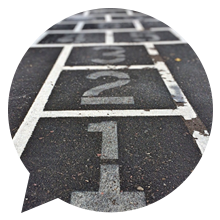Play area surfacing

The legal position
There is no legal requirement for protective surfacing to be provided on children's playgrounds. It is, however, recommended by safety organisations such as RoSPA, BSI, NPFA and CAPT.
The Department of the Environment 'strongly recommended' its use in 1978 while the Department of Culture, Media and Sport (currently the Government's lead body on playgrounds) advised its use in their Playground Safety Guidelines (1993) as one of the design elements of a safe playground. The Health and Safety Executive has also recommended it.
It is fair to say that recent out-of-court settlements arising from playground accidents have suggested the courts recognise that the provision of suitable surfaces represents good practice, especially under new equipment.
Accident prevention
There is no doubt that head injuries to children are reduced in severity by the provision of protective surfaces but such falls are a rare occurrence for children over five. It will not reduce accidents but may reduce the severity of injury from falls to the playground surface - that is about 50% of injuries resulting in a hospital visit. There is some evidence that it will not reduce long-bone fractures, especially of the upper body. About 30% of fall injuries are related to equipment. Surfacing is only of limited significance to accidents and its provision should be viewed in perspective.
Types of surfacing
As a general principle there are three main types of protective surfacing for play areas:
Grass
A good, all-purpose surface, but with little wear resistance or impact absorbency in dry conditions.
Loose-fill materials
These include sand, wood products and pea shingle. They have good impact absorbency but disperse and break-down. They are not suitable for moving equipment. Easy to lay.
Synthetic surfaces
There are three main types:
Tiles - generally efficient, long-lasting but can be expensive and difficult to lay.
Wet-pour - generally efficient, long-lasting but expensive and very difficult to lay.
Layered - generally efficient but require some maintenance and can be subject to vandalism and wear problems. Requires expert laying.
Assessing for surfacing
Provision under old equipment
Protective surfaces are expensive so before installing them for existing equipment consider:
- Compliance with Standards,
- Play value,
- Site position, design and use
- Age of equipment
- Foot-print
It is not necessary to provide a protective surfacing immediately for older equipment - have a planned programme of improvement as part of a Play Policy (See RoSPA book)
Provision under new equipment
All new equipment should be provided with an appropriate surface. Under 600mm high this need not be a protective surface, but should have some impact attenuation. In some cases (e.g. Spring items) some ground protection may be required. Grass re-enforcement materials can be used.
Purchasing surfaces
It is recommended that suppliers should give written assurance that their product has been tested in accordance with BS7188 and EN1177. It should be installed to the areas given in EN1176. Copies of appropriate test certificates should be supplied on request. Obtain written assurance that the material will maintain its absorbency levels for the warranty period. On-site testing is available - ask RoSPA for details.
Table of Surfacing Comparisons
| * |
Eq.suit. |
Imp.Att. |
Access |
Install. |
Durab. |
Maint. |
Cost |
| Concrete/tarmac |
None |
None |
High |
Easy |
V.good |
Low |
Low |
| Earth/ hoggin |
V.low items |
V. low |
Poor |
Easy |
Low |
Medium |
Low |
| Grass |
Low items |
Good if wet |
Poor |
Easy |
Low |
Medium |
Low |
| Sand |
Static |
High |
Poor |
Easy |
Good |
High |
Low |
| Wood |
Static |
High |
Poor |
Easy |
Fair |
High |
Low |
| Shingle |
Static |
High |
Poor |
Easy |
High |
High |
Low |
| Cast tiles |
All |
High |
Good |
Difficult |
Good |
Low |
High |
| Wrap tiles |
All |
High |
Good |
Mod. |
V. good |
Low |
High |
| Bonded pavers |
Static |
Low |
Good |
Mod. |
V. good |
Low |
High |
| In-situ lays |
All |
High |
High |
Difficult |
Good |
Low |
High |
| Layered |
All |
Mod. |
Low |
Mod. |
Fair |
Mod. |
Mod. |
Key:
Eq. Suit. = Equipment suitability
Imp. Att. = Impact attenuation
Acc. = Accessibility for wheeled items/mobility aids
Instl. = Ease of installation
Dura. = Durability
Maint. = Maintenance requirements
Cost = Installation costs
Mod. = Moderate
v. gd = Very good
Vlow = Very low
Med. = Medium